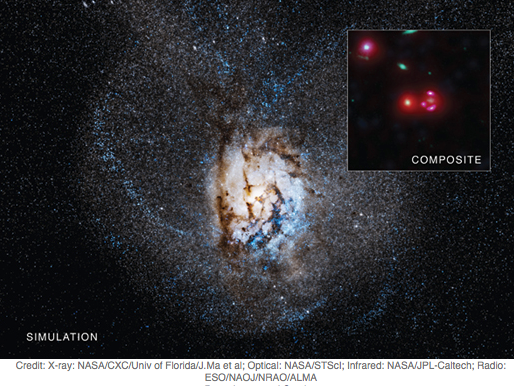
Astronomers discovered a galaxy, known as SPT 0346-52, that lies 12.7 billion years from Earth and undergoes an extraordinary rate of star formation. The galaxy was formed only about a billion years after the Big Bang. It was first detected using the National Science Foundation’s South Pole Telescope (SPT) and was later observed with several other space and ground-based telescopes. The first data revealed a very bright infrared emission that indicated an enormous burst of star formation. However, this emission could also be attributed to a growing supermassive black hole at the centre of the galaxy. In the latter case, the black hole would grow by falling matter onto it, and become much hotter and brighter producing X-rays and infrared light. Therefore, scientists used NASA’s Chandra X-ray Observatory and CSIRO’s Australia Telescope Compact Array, a radio telescope. These observations didn’t show any X-ray or radio emission and therefore the black hole hypothesis was ruled out.
Further analysis of the available data showed that SPT 0346-52 forms stars at a rate of about 4,500 times the mass of the Sun every year. In comparison, our Milky Way forms about one solar mass of new stars per year. This high rate of star formation indicates that a large reservoir of cool gas in the galaxy is being converted into stars with unusually high efficiency.
Studying more galaxies like SPT 0346-52 will help astronomers learn more about the formation and growth of massive galaxies and their co-evolution with the supermassive black holes that live in their centres.
Publication: Ma et al. 2016
Source: Chandra
